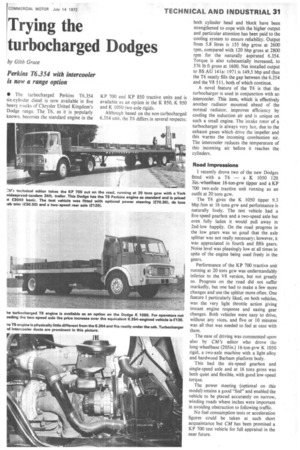Trying the turbocharged Dodges
Page 33

If you've noticed an error in this article please click here to report it so we can fix it.
by Gibb Grace
Perkins T6.354 with intercooler is now a range option
• The turbocharged Perkins T6.354 six-cylinder diesel is now available in five heavy trucks of Chrysler United Kingdom's Dodge range. The T6, as it is popularly known, becomes the standard engine in the KP 700 and KP 850 tractive units and is available as an option in the K 850, K 950 and K 1050 two-axle rigids.
Although based on the non-turbocharged 6.354 unit, the T6 differs in several respects: both cylinder head and block have been strengthened to cope with the higher output and particular attention has been paid to the cooling system to ensure reliability. Output from 5.8 litres is 155 bhp gross at 2600 rpm, compared with 120 bhp gross at 2800 rpm for the naturally aspirated 6.354. Torque is also substantially increased, to 376 lb ft gross at 1600. Net installed output to BS AU 141a: 1971 is 149.5 bhp and thus the T6 neatly fills the gap between the 6.354 and the V8 511, both of which continue.
A novel feature of the T6 is that the turbocharger is used in conjunction with an intercooler. This item, which is effectively another radiator mounted ahead of the normal radiator, improves efficiency by cooling the induction air and is unique on such a small engine. The intake rotor of a turbocharger is always very hot, due to the exhaust gases which drive the impeller and this warms the incoming combustion air. The intercooler reduces the temperature of this incoming air before it reaches the cylinders.
Road Impressions I recently drove two of the new Dodges fitted with a T6 — a K 1050 12f1 3in.-wheelbase 16-ton-gvw tipper and a KP 700 two-axle tractive unit running as an outfit at 20 tons gcw.
The T6 gives the K 1050 tipper 9.3 bhp /ton at 16 tons gvw and performance is naturally lively. The test vehicle had a five-speed gearbox and a two-speed axle but even fully laden it would pull away in 2nd-low happily. On the road progress in the low gears was so good that the axle splitter was not really necessary; however, it was appreciated in fourth and fifth gears. Noise level was pleasingly low at all times in spite of the engine being used freely in the gears.
Performance of the KP 700 tractive unit running at 20 tons gcw was understandably inferior to the V8 version, but not greatly so. Progress on the road did not suffer markedly, but one had to make a few more changes and use the splitter more often. One feature I particularly liked, on both vehicles, was the very light throttle action giving instant engine response and easing gear changes. Both vehicles were easy to drive, without any vices, and five or 10 minutes was all that was needed to feel at ease with them.
The ease of driving was commented upon also by CM'S editor who drove the long-wheelbase (205in.) 16-ton-gvw K 1050 rigid, a two-axle machine with a light-alloy and hardwood Barham platform body.
This had the six-speed gearbox and single-speed axle and at 16 tons gross was both quiet and flexible, with good low-speed torque.
The power steering (optional on this model) retains a good "feel" and enabled the vehicle to be placed accurately on narrow, winding roads where inches were important in avoiding obstruction to following traffic.
No fuel consumption tests or acceleration figures could be taken at such short acquaintance but CM has been promised a KP 700 test vehicle for full appraisal in the near future.






























































































